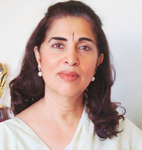
Dr. Urvashi Sahni
Last month, India emblemized its role as the world’s largest democracy as over 800 million eligible voters went to the polls in what may have been the largest democratic event in history. High on the list of priorities for all contesting parties was women’s empowerment, women’s equality and overall safety for women. In fact, surveys show more than 90 percent of Indian voters see combating violence against women as a priority and 75 percent of men and women believe that the political promises made to advocate women’s rights have been inadequate so far.
There is good cause for Indians to be concerned that not enough has been done for women in their country. According to India’s National Crime Records Bureau, more than 25,000 rape cases were reported across the country in 2012 alone. Out of these, almost 98 percent were committed by a relative or neighbor. Additional statistics are no less troubling: latest estimates suggest that a new case of rape is reported every 22 minutes in India, a dowry death occurs every 77 minutes, and a case of cruelty committed by either a husband or husband’s relative occurs every 9 minutes. Forty-seven percent of girls are married by 18 years of age, and 18 percent are married by 15 years of age, resulting in around 39,000 child marriages taking place each day. From a global perspective, 40 percent of the world’s child brides are from India.
Even before girls reach their teenage years, they face distressing challenges in India. Many more girls than boys die before reaching the age of 5. And with female feticide approaching nearly 1 million a year, fewer girls are born. Indeed, our sex ratio is at 914 women to 1,000 men, the lowest it has been since independence in 1947.
Domestic violence and gender disparities are especially pronounced in India’s northern states. Women and girls In Uttar Pradesh, in particular, suffer physical abuse at rates of 18-45 percent, non-consensual sex at rates of 18-40 percent, and physically forced sex at rates of 4-7 percent.
These are terrifying statistics. While the government has tried to boost girls’ education and has made some significant gains (females are now enrolled in primary school almost at parity with men), girls are still far from equal in India. Only 40 percent finish 10th grade. Ultimately, the social climate at home and in communities is too discriminatory to allow for girls being educated or becoming autonomous, equal persons.
Dissatisfied with the government’s efforts, NGOs, women’s movements, journalists, economists, academics and lawyers are promoting their “Womanifesto,” a six-point plan, first drafted last year, that details what needs to be done within the next five years to improve conditions for India’s women and girls. First on the list is “Educate for Equality.” It reads, “We will implement comprehensive, well-funded and long-term public education programs to end the culture of gender-based discrimination and violence. These will include: SMS, radio and TV public service campaigns, accessible lesson plans for schools, and modules for training teachers. To this end we will reach men, women, boys and girls in both urban and rural areas.” Significantly, it specifically speaks of education “for equality,” and not a more watered-down, paternalistic “education for girls.”
The group that I’ve founded, Study Hall Education Foundation (SHEF), has been doing just this. In the last decade, we have adopted the motto of “educate for equality,” understanding that not only is mere enrolment not enough but a gender-neutral academic education is not sufficient to empower girls and will not necessarily lead to better life outcomes. We embed strong, focused, rights-based empowerment programs within schools’ curriculums with very encouraging outcomes. Teachers are led to examine their own gendered mindsets and trained to become advocates for girls’ rights. The teachers then help girls become advocates for themselves and for all girls’ rights. They have a large parent community that they can influence and they use all their interactions with parents as platforms of advocacy.
Our program has reached out to 4,000 adolescent girls, 300 teachers and over 16,000 parents. Teachers have started using their parent teacher meetings to discuss issues like gender discrimination, child marriage, dowry, girls’ right to education and violence against girls. Girls participate in these meetings, using drama to give voice to feelings of oppression and to stake their claim to their right to equal personhood. Interestingly, parent attendance at these meetings has increased 55 percent since the teachers began using them as platforms to discuss gender issues. Teachers report that parents are finding the meetings much more meaningful and are engaging actively in discussions centered on issues that are close to them.
As part of SHEF’s efforts to educate wider communities on gender, we organized a large campaign against child marriage, which impacted approximately 16,000 teachers, students and members of the community. The month-long campaign brought critical dialogues into the classroom, and kicked off discussions with parents at parent teacher meetings. It culminated in a student and teacher-led march through the community, where students and teachers from 43 schools across four districts in Uttar Pradesh shouted slogans against child marriage and for girls rights, performed street plays in the villages and enlisted support from community adults via signature campaigns.
If India is to become a better place for all of its children, then it is vital that we value and respect our daughters. We must move the conversation of girls’ education from “learning outcomes” to “life outcomes” and take up “education for equality” as our mantra across the country. We should include gender education in our curriculum for both boys and girls. And we should teach these lessons not just to our students, but also to their parents and communities in order to construct an egalitarian gender perspective. This is imperative if India is to fulfill its constitutional promise of gender equality.
 DONATE
DONATE


 Volunteer
Volunteer
 Work With Us
Work With Us
